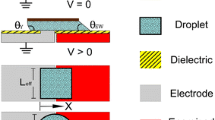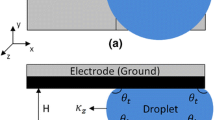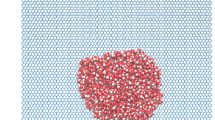Abstract
This paper examines the electrostatic force on a microdroplet transported via electrowetting on dielectric (EWOD). In contrast with previous publications, this article details the force distribution on the advancing and receding fluid faces, in addition to presenting simple algebraic formulae for the net force in terms of system parameters. Dependence of the force distribution and its integral on system geometry, droplet location, and material properties is described. The consequences of these theoretically and numerically obtained results for design and fabrication of EWOD devices are considered.











Similar content being viewed by others
References
Bahadur V, Garimella S (2006) An energy-based model for electrowetting-induced droplet actuation. J Micromech Microeng 11(8):1494–1503
Baird E, Mohseni K (2005) Surface tension actuation of droplets in microchannels. IMECE 2005-79371, 2005 ASME international mechanical engineering congress and R&D expo, Orlando
Beni G, Hackwood S, Jackel J (1982) Continuous electrowetting effect. Appl Phys Lett 40(10):912–914
Buehrle J, Herminghaus S, Mugele F (2003) Interface profiles near three-phase contact lines in electric fields. Phys Rev Lett 91(086101):1–4
Chen J, Troian S, Darhuber A, Wagner S (2005) Effect of contact angle hysteresis on thermocapillary droplet actuation. J Appl Phys 97(014906):1–9
Cho S, Fan S, Moon H, Kim C (2002) Towards digital microfluidic circuits: creating, transporting, cutting, and merging liquid droplets by electrowetting-based actuation. In: Technical digest. MEMS, proceedings of 15th IEEE international conference, pp 32–35
Cho S, Moon H, Kim C (2003) Creating, transporting, cutting, and merging liquid droplets by electrowetting-based actuation for digital microfluidic circuits. J MEMS 12(1):70–80
Cooney C, Chen C-Y, Emerling M, Nadim A, Sterling J (2006) Electrowetting droplet microfluidics on a single planar surface. Microfluid Nanofluid (Online first)
Darhuber A, Valentino J, Troian S, Wagner S (2003) Microfluidic actuation by modulation of surface stresses. Appl Phys Lett 82:657
Dolatabadi A, Mohseni K, Arzpeyma A (2006) Behaviour of a moving droplet under electrowetting actuation: numerical simulation. Can J Chem Eng 84(1):17–21
Fair R, Srinivasan V, Ren H, Paik P, Pollack M (2003) Electrowetting-based on-chip sample processing for integrated microfluidics. In: IEEE international electron devices meeting (IEDM)
Griffiths D (1972) Introduction to electrodynamics. Prentice-Hall, Englewood Cliffs
Jackson J (1998) Classical electrodynamics. Wiley, New York
Jones T (2002) On the relationship of dielectrophoresis and electrowetting. Langmuir 18:4437–4443
Jones T (2005) An electromechanical interpretation of electrowetting. J Micromech Microeng 15:1184–1187
Kang K (2002) How electrostatic fields change contact angle in electrowetting. Langmuir 18(26):10318–10322
Kang K, Kang I, Lee C (2003) Wetting tension due to coulombic interaction in charge-related wetting phenomena. Langmuir 19(13):5407–5412
Landau L, Lifshitz E, Pitaevskii L (1984) Electrodynamics of continuous media, vol 8, 2nd edn. Pergamon, New York
Lee J, Moon H, Fowler J, Schoellhammer T, Kim C (2002) Electrowetting and electrowetting-on-dielectric for microscale liquid handling. Sens Actuators Phys A 95:259–268
Mohseni K, Baird E, Zhao H (2005) Digitized heat transfer for thermal management of compact microsystems. IMECE 2005-79372, 2005 ASME international mechanical engineering congress and R&D expo, Orlando
Moon H, Cho S, Garrell R, Kim C (2002) Low voltage electrowetting-on-dielectric. J Appl Phys 92(7):4080–4087
Mugele F, Baret JC (2005) Electrowetting: from basics to applications. J Phys Condens Matter 17(28):R705–R774
Oleg S, Alexander N (2004) Thermocapillary flows under an inclined temperature gradient. J Fluid Mech 504:99–132
Papathanasiou A, Boudouvis A (2005) Manifestation of the connection between dielectric breakdown strength and contact angle saturation in electrowetting. Appl Phys Lett 86(16)
Pollack M (2001) Electrowetting-based microactuation of droplets for digital microfluidics. PhD thesis, Duke University
Pollack M, Shenderov A, Fair R (2002) Electrowetting-based actuation of droplets for integrated microfluidics. Lab Chip 2(2):96–101
Saeki F, Baum J, Moon H, Yoon J, Kim C (2001) Electrowetting on dielectrics: reducing voltage requirements for microfluidics. Abstr pap Am Chem Soc, 222(8-PMSE part 2)
Shapiro B, Moon H, Garrell R, Kim C (2003) Equilibrium behavior of sessile drops under surface tension, applied external fields, and material variations. J Appl Phys 93(9):5794–5811
Vallet M, Vallade M, Berge B (1999) Limiting phenomena for the spreading of water on polymer films by electrowetting. Eur Phys J B 11(4):583–591
Wang K, Jones T (2005) Electrowetting dynamics of microfluidic actuation. Langmuir 21:4211–4217
Wheeler A, Moon H, Kim C, Loo J, Garrell R (2004) Electrowetting-based microfluidics for analysis of peptides and proteins by matrix-assisted laser desorption/ionization mass spectrometry. Anal Chem 76:4833–4838
Wheeler A, Moon H, Bird C, Loo R, Kim C, Loo J, Garrell R (2005) Digital microfluidics with in-line sample purification for proteomics analyses with maldi-ms. Anal Chem 77:534–540
Woodson H, Melcher J (1968a) Electromechanical dynamics. Part I. Discrete systems. Wiley, New York
Woodson H, Melcher J (1968b) Electromechanical dynamics. Part II. Fields, forces, and motion. Wiley, New York
Woodson H, Melcher J (1968c) Electromechanical dynamics. Part III. Elastic and fluid media. Wiley, New York
Zeng J (2006) Modeling and simulation of electrified droplets and its application to computer-aided design of digital microfluidics. IEEE Trans Comput Aided Des Integr Circuits Syst 5(2):224–233
Zeng J, Korsmeyer T (2004) Principles of droplet electrohydrodynamics for lab-on-a-chip. Lab Chip 4:265–277
Acknowledgments
The authors would like to acknowledge partial funding under AFOSR Contract No. FA9550-05-1-0334 and NSF Contract No. CTS-05-40004 to K.M.
Author information
Authors and Affiliations
Corresponding author
Rights and permissions
About this article
Cite this article
Baird, E., Young, P. & Mohseni, K. Electrostatic force calculation for an EWOD-actuated droplet. Microfluid Nanofluid 3, 635–644 (2007). https://doi.org/10.1007/s10404-006-0147-y
Received:
Accepted:
Published:
Issue Date:
DOI: https://doi.org/10.1007/s10404-006-0147-y




